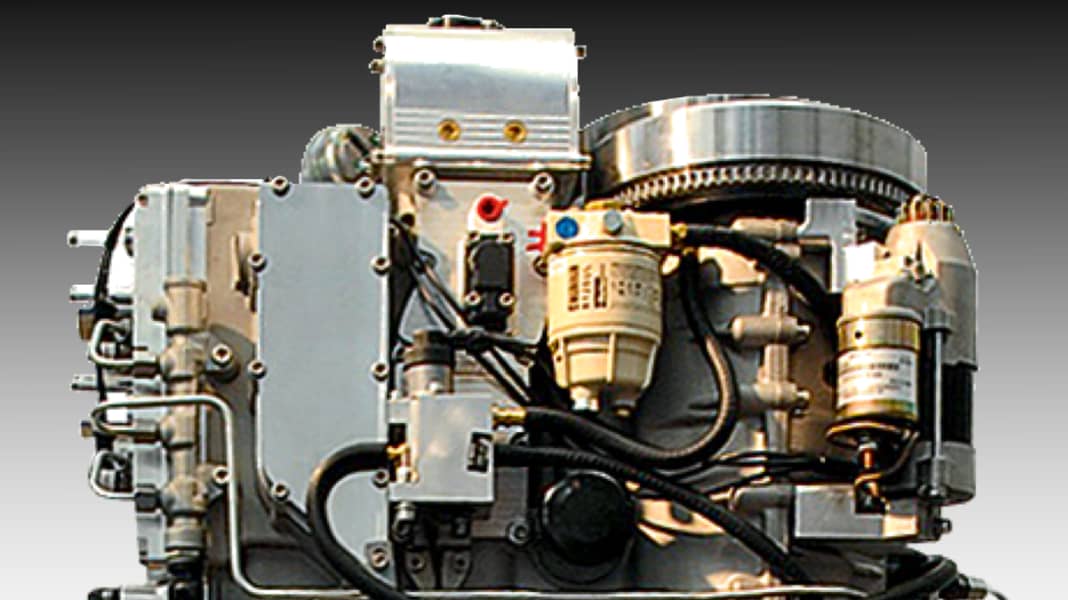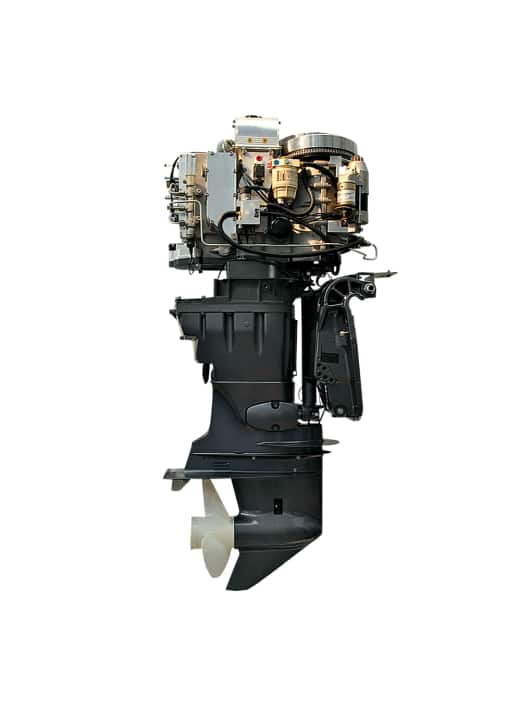

Question: What does Werner, who became a superstar as a comic character and the main actor in the books and adventure films named after him, have to do with the world's first turbodiesel outboard motor? Answer: At first glance, nothing. However, anyone who has read or watched the "comic strips" carefully knows that the plumber's apprentice from the far north is not only enthusiastic about "bottled beer and flatheads". Extravagant motorbikes and powerful engines are his great love. The "Red Porsche Killer", which "Ölfuß" Wolfgang Ußleber equipped with four (!) Horex engines, and the 1988 race against "Holgi's" Porsche at the airfield in Hartenholm became legendary.
Is it a reminiscence of the good old days? Philipp Hitzbleck and Lutz W. Lester, who as Marketing Director and Board Officer of the "Achterbahn-Verlag" publishing house, which went bankrupt in 2002, were partly responsible for the fact that people read and saw Werner comics, want to realise the 22-year-old idea, developed together with "Werner father" Rötger (Brösel) Feldmann, of building a production-ready motorbike with a turbo diesel engine.
The foundation of the Neander Motors AG based in Kiel is the first step and is quickly taken. The second, getting some really good engine people interested in the "crazy idea", doesn't take much longer. The result of the passionate liaison, a unique motorbike not only because of its 100 hp diesel engine, was awarded the Schmidt-Römhild Technology Prize by the Schleswig-Holstein Minister for Science, Economics and Transport in 2009. Among other things, the award recognises the innovative potential and pioneering nature of the technology and rewards it with a substantial "cash injection".
Success is known to make you efficient. So the idea of attaching the excellent technology to a 508 mm or 635 mm high boat transom is almost inevitable. - The idea of building a diesel outboard is not new. Yanmar did it in the nineties with two models (27 and 36 hp), but was not very successful in the long term.
The reason: the engines vibrated strongly, were large, heavy and loud. And they were anything but cheap. The undoubted advantages compared to petrol engines, such as reliability, long service life, safety and fuel savings, could only convince commercial users at the time - if at all - that signing the purchase contract was a wise decision. What does that teach us? If the now almost finished turbodiesel outboard engine, which for a long time only existed in the minds of the entrepreneurial duo Hitzbleck-Lester, is to establish itself successfully on the market, it must be significantly better than its Japanese predecessors. And it was clear from the outset that such an engine could not be offered for "little money" and would therefore (only) be of no interest to leisure captains. The question remains: How can real professionals be convinced?
Club of clever minds
Hitzbleck and Lester know how to set up a functioning company, but not how to build a turbodiesel outboard engine suitable for everyday use. The solution to the problem is called "copy and paste". To put it simply: copy and paste (the motorbike concept). In other words, you look for investors who are convinced by the idea and the project and, once you have found them, you "create" a wholly-owned subsidiary of Neander Motors AG, Neander Shark GmbH, which - like the parent company - is an engine developer but not a manufacturer.
If development work is to be successful, it needs clever minds. One of them is Claus Brüstle, one of the "inventors" of Mercury's Verado and now North America President of Emitec. The global emissions technology company "takes care" of reducing fuel consumption, particulate emissions and CO2 emissions in the Neander engine. Sounds simple at first, but it's incredibly complicated and just as important.
Rick Davis is no less clever. The former (1995 to 2010) Vice President of Mercury is undisputedly one of the most experienced and best outboard engine developers in the world. Ulrich Witwer also has brains, as the saying goes. As a former Mahle Director and current Managing Director of Neander Shark GmbH, the engineer knows everything there is to know about pistons and the like.
Partner with expertise
Equipped with the same "rank", Lutz W. Lester is on the lookout for strong partners. The 51-year-old business economist has found more than half a dozen renowned companies, such as Robert Bosch GmbH, which equips the Neander engine with common-rail direct injection and electronic engine management. Together, these two features make the engine economical and clean, while also ensuring that it runs smoothly.
Lester's "wanted and found list" also includes FEV from the USA and the specialist for high-performance engines, capricorn from Düsseldorf, which has its roots in international motorsport. The former supplies the calculations required for the production of the light metal powerhead. The customised - i.e. specially designed for the high torques of the Neander engine - underwater part is "made in Italy". Original quote from Lester: "We chose Selva because the people from Tirano have the necessary expertise and experience and in this case we were looking for a medium-sized partner from Europe."
The Munich University of Applied Sciences, with which NeanderMotors has been working for ten years, was chosen as a partner because of its expertise and the fact that it has the only high-performance test bench for outboard engines in Germany.
The Neander engine, an 800 cc two-cylinder diesel engine with turbocharger and intercooler, which develops its maximum torque of 120 Nm at 2000 rpm, has been on board for some time. If you want to utilise its maximum output of 40 kW (55 hp), the diesel, which is equipped with four-valve technology, two overhead camshafts and a timing chain, has to rev at 4500 rpm.
The fact that a double crankshaft rotates is unique and the Neander engine's recipe for success. The two counter-rotating crankshafts (coffee grinder principle) coupled via gearwheels create a compact engine design and, together with the counterweights in the gearwheels, reduce vibrations to a minimum. In addition, the pistons are virtually free of lateral forces, which has a demonstrably positive effect on frictional power.
Initial test bench results show a high torque and at least as high a savings potential, which makes the Neander engine particularly interesting for commercial users, as intended. If you take fuel consumption and current fuel prices alone as a yardstick, the considerable purchase costs are amortised "after just" 1000 operating hours. Sounds good. At least for professionals.
For leisure captains, both the operating hours mentioned and the price of 26,000 euros are "beyond good and evil". Arguments such as safety, environmental friendliness, service life and operational reliability lose their impact relatively quickly. All that remains for the average petrol boat driver is the hope that the engine, which is due to go into series production in mid-2014, will quickly become a commercial success and that prices will fall as a result.
Without a "volume discount", the 55 hp turbodiesel, which can easily be turned into an 80cc by increasing the displacement and/or boost pressure (where it would also be competitive in terms of weight), remains a case for the professionals.
It goes without saying that the innovative self-igniter must fulfil the requirements of classification societies such as Germanischer Lloyd for its premiere. It is also clear that sales, service and spare parts supply will be handled by authorised partners in Norway, Italy and England. In Germany, the company Marx in Hamburg, which has gained experience with Yanmar's diesel outboards, is the point of contact.
The conclusion is six years old and comes from the pen of our colleagues at MTZ (Motortechnische Zeitschrift), who scrutinised the 100 hp 1.4-litre motorbike engine in 2006.
Quote: "With the new Neander diesel engine, we have succeeded for the first time in presenting a powerful, compact diesel engine with turbocharging and direct injection for a motorbike. Its layout as a transverse parallel twin is characterised by many innovative solutions. This means that the typical diesel characteristics of a car, such as high torque, good elasticity, low fuel consumption and great riding pleasure, can also be transferred to a motorbike." - End of quote.
The BOOTE writer - who merely wishes to replace the noun "motorbike" used twice with "outboard motor" - has nothing more to add.
TECHNICAL DATA
- Type of construction Four-stroke turbodiesel
- Cylinder 2 in series
- Bore and stroke 80 x 80 mm
- Displacement 800 cc
- Performance 40 kW (55 hp)
- Maximum torque 120 Nm at 2000 rpm
- Full load speed 4500/min
- Weight 155 kg
- Fuel Diesel
- Fuel system Common rail direct injection
- Cooling Water/single circle
- Generator 12 V/300 W
- Starter electric
- recommended Mirror height 508 and 635 mm
- Trim Power trim
- Gear ratio 2,07:1
- Gear shifting V-N-R
- Price 26,000 euros
- Distribution Friedrich Marx GmbH, Wendenstr. 8, 20097 Hamburg

